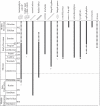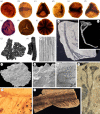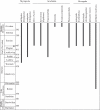A timeline for terrestrialization: consequences for the carbon cycle in the Palaeozoic
- PMID: 22232764
- PMCID: PMC3248713
- DOI: 10.1098/rstb.2011.0271
A timeline for terrestrialization: consequences for the carbon cycle in the Palaeozoic
Abstract
The geochemical carbon cycle is strongly influenced by life on land, principally through the effects of carbon sequestration and the weathering of calcium and magnesium silicates in surface rocks and soils. Knowing the time of origin of land plants and animals and also of key organ systems (e.g. plant vasculature, roots, wood) is crucial to understand the development of the carbon cycle and its effects on other Earth systems. Here, we compare evidence from fossils with calibrated molecular phylogenetic trees (timetrees) of living plants and arthropods. We show that different perspectives conflict in terms of the relative timing of events, the organisms involved and the pattern of diversification of various groups. Focusing on the fossil record, we highlight a number of key biases that underpin some of these conflicts, the most pervasive and far-reaching being the extent and nature of major facies changes in the rock record. These effects probably mask an earlier origin of life on land than is evident from certain classes of fossil data. If correct, this would have major implications in understanding the carbon cycle during the Early Palaeozoic.
Figures





References
-
- Labandeira C. C. 2005. Invasion of the continents: cyanobacterial crusts to tree-inhabiting arthropods. Trends Ecol. Evol. 20, 253–26210.1016/j.tree.2005.03.002 (doi:10.1016/j.tree.2005.03.002) - DOI - DOI - PubMed
-
- Gensel P. G. 2008. The earliest land plants. Annu. Rev. Ecol. Evol. Syst. 39, 459–47710.1146/annurev.ecolsys.39.110707.173526 (doi:10.1146/annurev.ecolsys.39.110707.173526) - DOI - DOI
-
- Shear W. A., Selden P. A. 2001. Rustling in the undergrowth: animals in early terrestrial ecosystems. In Plants invade the land: evolutionary and environmental perspectives (eds Gensel P. G., Edwards D.), pp. 29–51 New York, NY: Columbia University Press
-
- Beerling D. J., Berner R. A. 2005. Feedbacks and the coevolution of plants and atmospheric CO2. Proc. Natl Acad. Sci. USA 102, 1302–130510.1073/pnas.0408724102 (doi:10.1073/pnas.0408724102) - DOI - DOI - PMC - PubMed
-
- Berner R. A. 1999. Atmospheric oxygen over Phanerozoic time. Proc. Natl Acad. Sci. USA 96, 10 955–10 95710.1073/pnas.96.20.10955 (doi:10.1073/pnas.96.20.10955) - DOI - DOI - PMC - PubMed
Publication types
MeSH terms
Substances
LinkOut - more resources
Full Text Sources
